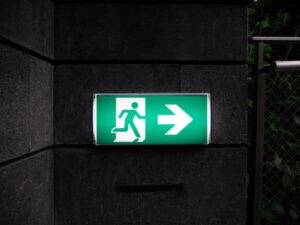5 Emergency Lighting Tips: Your Guide To A Safer Business
Posted by Emma Reid on 1st Jun 2022

Emergency lighting is key to maximising safety in your commercial properties! Here’s our quick guide on where you need it, and what factors you need to consider.
In an emergency situation, even places with which we are very familiar can become alien and disorientating. Good lighting can help prevent this, helping both employees and guests safely navigate out of a dangerous situation.
Some Key Words
- Maintained/Non-Maintained: a maintained light is one that will operate normally off of mains power when there is no emergency, with an emergency battery kicking in if there’s a power cut. A non-maintained light will only kick in during an emergency.
- Lux- this is a measure of illumination. One lux is equal to one lumen per metre². Emergency lighting goals tend to use Lux instead of lumens, because Lux are a better measure of how much light is in a specific space.
Now with all this in mind, what do you need to consider when planning your emergency lighting set up?
1) Panic Management
You can have the strongest evacuation procedures in the world- but if panic sets in people won’t remember them. That’s why good emergency lighting is key. People are much less likely to panic if they’re not suddenly plunged into darkness.
It’s really important to consider what each room in your building is used for and account for it accordingly in your emergency lighting plan, as this will reduce the risk of someone being caught out.
Particular care should be given to toilets (especially those that might be used by people with disabilities), car parks, stairways (particularly near the bottom escalators) and areas with heavy machinery.
2) Confusion Due To Poor Signage
Confusion leads to panic, so good signage that can easily direct people is key! That’s why the iconic green fire escape sign is so widespread, it tells people at a glance what they’re looking at and where they need to go. These signs should be lit in some way, so that they can be seen even with reduced visibility.
We have numerous LED signs in stock, with options for internally lit or externally lit (also known as backlit) signage. Crucially, make sure you’re using consistent signage across your property, or else you will confuse people further.
3) Dangerous Industrial Equipment Is Left Running
This is a very important consideration for industrial sites like warehouses and factories, but don’t neglect it if you’re in a more conventional building, there are a range of machines and hazardous substances that may need to be considered.
Where there’s an incredibly high risk, there needs to be no disruption to lighting, so you need emergency batteries that will kick in instantly. This is where a maintained light fitting is your best choice.
On top of this, the emergency lighting level should be at least 10% of the normal amount of light required, but no less than 15 lux. This is where LED lighting is your best bet, its efficiency makes reaching that lux level relatively simple.
4) Poorly Lit Escape Routes
Escape routes, particularly through long corridors and stairwells, are a particularly dangerous part of the evacuation process. Sudden unexpected turns and corners can take a smooth and orderly walk to a safe area into a tense or haphazard escape, with a much higher risk of injury.
Regulations say that you should have a minimum of 1 lux along the centre of an escape route, with extra illumination indicating changes of direction (such as bends) or gradient changes, as well as corridor intersections and doorways.
The Sentinel 1W Recessed 3 Hour Emergency Escape Route Fitting is a popular choice for escape route lighting!
5) Locating Key Areas
First aid points, call points, muster areas and firefighting equipment should always be lit by at least 5 lux from a vertical point. This makes them easy to locate and operate.
Nobody likes to think about emergencies, but with proper planning, a good risk assessment and solid lighting, you can ensure that your business is as safe as possible.
If you’re looking for ways to improve safety in your business, don’t hesitate to get in touch with us on 0116 321 4120 or send an email to cs@wled.co.uk. We can talk you through your emergency lighting needs.
You can also follow us on YouTube, Twitter, Instagram or Facebook.





